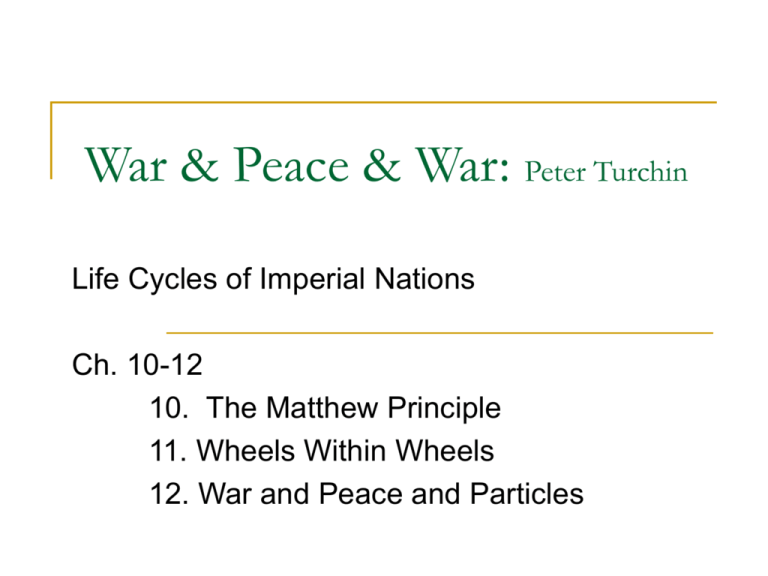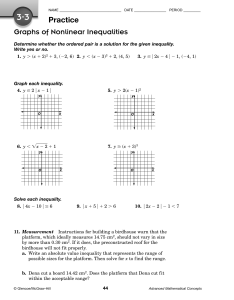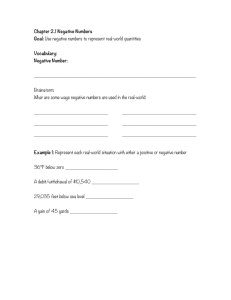Mehran Salehi
advertisement

War & Peace & War: Peter Turchin Life Cycles of Imperial Nations Ch. 10-12 10. The Matthew Principle 11. Wheels Within Wheels 12. War and Peace and Particles “Why the rich get richer and the poor get poorer Secular cycle effects practically all facets of social life Especially determines trend in social and economic inequality Economic inequality has a large effect on peoples willingness to participate/cooperate How does social and economic inequality effect politics? Robert Axtell and Joshua Epstein developed a computer modeling program known as “Sugarscape” so that they could model a economy containing “sugar” and “spice” The program was designed so that one could control specific variables effecting social and economic stratification Agents went around collecting, storing and consuming these goods Economy function properly and maintained socioeconomic equality throughout society How does social and economic inequality effect politics? Allowing trade as first initial variable Agents began exchanging sugar for spice and vice versa Exchange rate was established depending on S&D As time went on the wealthy (those who stored sugar and spice) began to be distribute goods more unequally There were fewer rich and more poor as time progressed Positive Feedback Loop: rich get richer, poor get poor Model of Matthews Theory Goal: create a simple mathematical model, such that property can be inherited or sold and bought Assumption 1: property is divided equally amongst children Different families have different # of children More children per family = smaller wealth (land)/per child Leads to stratified socieity Model of Matthews Theory Assumption 2: “primogeniture” – oldest child inherits all of the land Introduces inequality even faster Now consider marriage General assumption is: wealthy man marries wealthy woman Fast rate of inequality How does wealth inequality translate to income inequality? Land by itself does not create income it has to be worked Rich families hire poor workers If available land > labor force then there is inefficiency If available land < labor force Labor shortage, increase in wages for workers An option for the wealthy is to start renting out there land, but since there is a small demand, the price of renting is cheap Labor surplus, decrease in wages for workers, unemployment, high rent Overpopulation is a huge force driving inequality Problems with this Matthew Model As time goes on, we eventually reach a “inequality extreme” 1 individual owns all the property, overwhelming large unemployment and poverty When do we see a decrease in inequality Plague/disease: Ex. England in 1400: England had lost 50% of its pop due to disease Now pop << land, grain price goes down (b/c of surplus), rent goes down Low population means high wages, high employment High instability means low inequality (usually effects really rich and really poor, middle class is slightly effected War Ch. 11: Wheels within wheels - The Many Declines of the Roman Empire The rise and fall of empires are due to many fluctuations in social, political and economic arenas. The cyclical behaviors of these factors directly effect each other, giving rise and fall to each other until finally a great nation collapses. General Theory A general theory must be created so that we can differentiate between what is crucial and what is incidental to the fall of the Roman Empire The crucial variable is the collective capacity for action in a society, known as Asabiya Asabiya Competition between societies = high asabiya Competition within societies = low asabiya Expansion that pushes frontiers away from the center and removes forces that created high asabiya in the first place Weak internal structure, plagued by internal conflict, susceptibility Negative Feedback Loop Peace brings war, war brings peace…etc Decline of Asabiya Empires go through cycles of alternating integrative/disintegrative phases Generations get tired of fighting (so fighting tends to skip from generation to generation) Wheels within wheels Imperial nations go through 2,3, even 4 secular cycles before disintegration 1st secular Cycle (7th century to middle of 4th century B.C.) up to 500BC Marked by centralized, integrative forces 500BC – 400BC Marked by disintegrative, centrifugal tendencies Time table for st 1 Secular Cycle 450BC New political and social elite formed which led to Cohesive struggle against incoming Gauls, External wars of conquest Increased resources Reduced competition within society High asabiya High military success rate 349BC Romans turned back Gallic forces and conquered all of Mediterranean. “No country has even been greater or poorer…..” -Livy The negative aspects of the social forces driving secular cycle caught up with Rome Subjugated Cisalpine Gaul’s # of citizens doubled Massive population growth and Roman custom of equal partitioning of land to heirs Economic inequality Slavery exacerbated inequality Trade with orient profited the wealthy Initial Blows to Rome Removal of external conflicts Effects of luxury Conspicuous consumption Separation of wealthy and rich from common folk Slavery led to slave revolts Disintegrative forces Slave revolts, peasant rebellions, elites lose unifying forces, civil war Wheels are turning 1st two decades (140-120) was a time of contention Next 3 decades were relatively peaceful 90-70BC = civil war 70-50 = peaceful 50-30 = civil war, last phase of disintegrative phase Return to stability There were many casualties due to war Pruning of elites and redistribution of wealth There was more space and less people Progressive inheritance tax Execution were implemented on charges of treason Social mood Society was exhausted and ready for a new regime Return to stability “The end result was that during the 1st century of the principate the relative power of the most powerful and wealthy private individuals declined substantially with respect to that of the state. At the same time small landholders enjoyed a period of relative economic prosperity” st ….1 nd phase…..2 rd phase…3 phase There was internal peace and prosperity in 27BC However Rapid population growth Matthew principle returned with a vengeance Rich had taken over the core of Roman Empire (including Italy, Sicily) Plague Antimony plague struck Roman Empire Sensing weakness, Germanic and Sarmatic tribes pressed Roman Empire The final phase Marcus Aurelius tried to hold Rome together by debasing coins, but when Commodus took over political up-heavel began Civil wars broke out Political elites and senators assassinated one another Imperiopathosis of Roman nation went into its acute phase, and Rome died (~AD 268) War and Peace and Particles Tolstoy – attempted to explain history through mathematical equations Similar to that of LaPlacian statistics or Newtonian physics However, the universe cannot be modeled by a simple equation, it is ultimately stochastic “Only by taking infinitesimally small units for observations (the differential of history) and attaining to the art of integrating them (summing up their parts) can we hope to arrive at the laws of history Cliodynamics Offers insights not about certain individuals, but about all individuals in a group History is shaped by great impersonal forces, not by the actions of whole collectives of them A good scientific theory does not need to include everything we know about a subject. It needs to include only the stuff that is necessary to get the job done.









